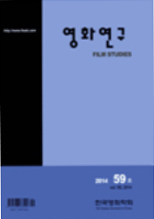- 영문명
- A Sociological Study on the Body in the Film, Pieta
- 발행기관
- 한국영화학회
- 저자명
- 육정학
- 간행물 정보
- 『영화연구』제55호, 385~408쪽, 전체 24쪽
- 주제분류
- 예술체육 > 예술일반
- 파일형태
- 발행일자
- 2013.03.31
5,680원
구매일시로부터 72시간 이내에 다운로드 가능합니다.
이 학술논문 정보는 (주)교보문고와 각 발행기관 사이에 저작물 이용 계약이 체결된 것으로, 교보문고를 통해 제공되고 있습니다.

국문 초록
영문 초록
This study aims to analyze Pieta, Kim ki-duk’s 18th and the first Korean film, winning the Leone D’Oro in the Venice film festival,through ‘body’ as subject, in terms of sociology; it focuses on analyzing the meaning of actors’ body and exploring how the social meaning of the body is represented as visual image. The results are as follows:First, according to a social discourse on the body, the viewpoint of body has been changed, with time or depending on scholars; from Cartesian ‘dichotomy between mind and body’ to Merleau-Ponty’s ‘human body as human being’ and body being ‘desire as production’ or ‘machine desire’in social perspective. But, most of the social constructionists believe that body can be seen as a social product, not only as a biological one. Body is a social being, therefore can be called a ‘connector’, facilitating social function of body. It is important for us to know the meaning that body as subject gives; the body in the film can be shown as visual image itself. Actors’ body plays a significant role in exploring the cinematic meaning. In short, the film has a dual body structure of Vision. Second, the meaning of the body in Pieta is divided into two bodies,Kang-do and a mother(Cho Min-soo). Kang-do’s body displays his mental impotence and instinctive sexual desire; the film reveals the deformed relationship between Kang-do and society, showing that kang-do earns a living by doing a bad deed. On the other hand, by expressing Kang-do’s sexual and instinctive desire, it replaces Kang-do impotent, negative body with sourceful one; it implies that Kang-do could be redeemed in a manner. Her body approaches theme of the film, ‘Salvation as pity for human life as it showcases grief and voluptuous beauty. Third, with regard to analysis on relationship between social behavior of the body and visual image, the visual area in Pieta is mostly represented as being antisocial. Antisocial behavior, as a visual element, as ‘violence,cruelty, and not feeling guilty’ occupies most of the first part and the film shows social message of ‘salvation’ as well as visual image in the second one. The antisocial elements are generally involved in Pieta; the spectators are certain to feel uncomfortable. The discomfort indicates that Kim ki-duk, the director of Pieta, has original directivity with a marked individuality. On the one hand, his directing film in a an antisocial way seems to be in disharmony with Korean audience longing for happy end.
목차
1. 서론
2. 몸에 대한 사회학적 담론
3. <피에타>에 나타나는 몸의 의미
4. 몸이 표현하는 사회적 행동과 영상 이미지
5. 결론
해당간행물 수록 논문
- 1920년대 초반 조선의 영화산업과 조선영화의 탄생
- <사랑방 손님과 어머니>의 각색과 3막구조 연구
- Early Silent Western Films: the establishment of the genre convention
- 통합예술교육과 STEAM(융합인재교육) 기반의 영화교육 교육과정 개발 필요성 연구
- 영화연기 고유성 측면에서 바라본할리우드 메소드 연기의 반작용
- <피에타>를 통해 본 몸의 사회학적 연구
- 한국영화에서 한국전쟁이 재현되는 변화과정에 관한 연구
- <도가니>(황동혁, 2011)와 <부러진 화살>(정지영, 2012)
- 영화와 기술 그리고 ‘사회적인 것’의 구성
- 한국 예술영화 담론의 흐름에 관한 연구
- 2000년대 한국 스릴러 영화의 모성 재현 연구
- 국제공동제작영화의 지원 정책과 현황 연구
- 변신모티브영화의 시각성
- 시뮬라시옹을 통해 본 <사랑을 카피하다>
- 자기조력적 영화치료와 상호작용적 영화치료의 효과 비교
- 영화연기의 내면성(內面性)에 관한 연구
- 관객으로서의 탈북자: 탈북의 자기표상과 영화 수용
- 영화연구 제55호 목차
- 독일 위생영화를 통해 본 조선 콜레라위생영화(1920)와 천연두위생영화(1922)의 특징과 한계
- 멜로 영화의 내적 리듬과 이미지에 관한 연구
- 이준익 영화의 카니발리즘 연구
- 윤봉춘 일기 연구
- 영화 <마더>에 나타난 수행적 모성 정체성에 관한 연구
- 2012년, 상호텍스트성의 어떤 경향
- 고레에다 히로카즈론
참고문헌
관련논문
예술체육 > 예술일반분야 BEST
- 생성형 AI 도구와 디자이너의 협업 프로세스 개발 - 이미지를 통한 아이디어 확산에서 고해상도 렌더링까지
- ‘일과 삶의 균형(Work-Life Balance)’ 척도 개발을 위한 연구
- 디자인 전공 교과목에서의 생성형 AI 도구 활용 사례 연구
예술체육 > 예술일반분야 NEW
- 한국영화의 촬영과 조명 시리즈 2: 영화 '형사, Duelist'의 Visual Concept 및 조명플랜
- 포스트모더니즘적 영상표현에 관한 연구 -실사 영화와 애니메이션 영화의 상호작용을 중심으로-
- 소니 HVR-Z1N 카메라의 중요한 메뉴에 관한 소고
최근 이용한 논문
교보eBook 첫 방문을 환영 합니다!

신규가입 혜택 지급이 완료 되었습니다.
바로 사용 가능한 교보e캐시 1,000원 (유효기간 7일)
지금 바로 교보eBook의 다양한 콘텐츠를 이용해 보세요!



